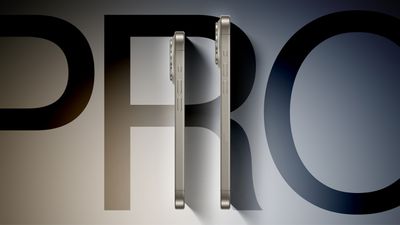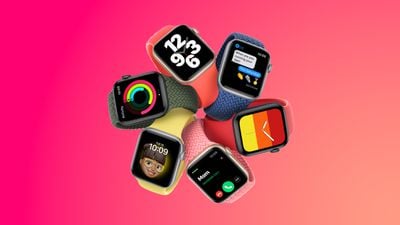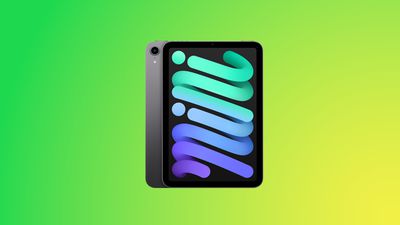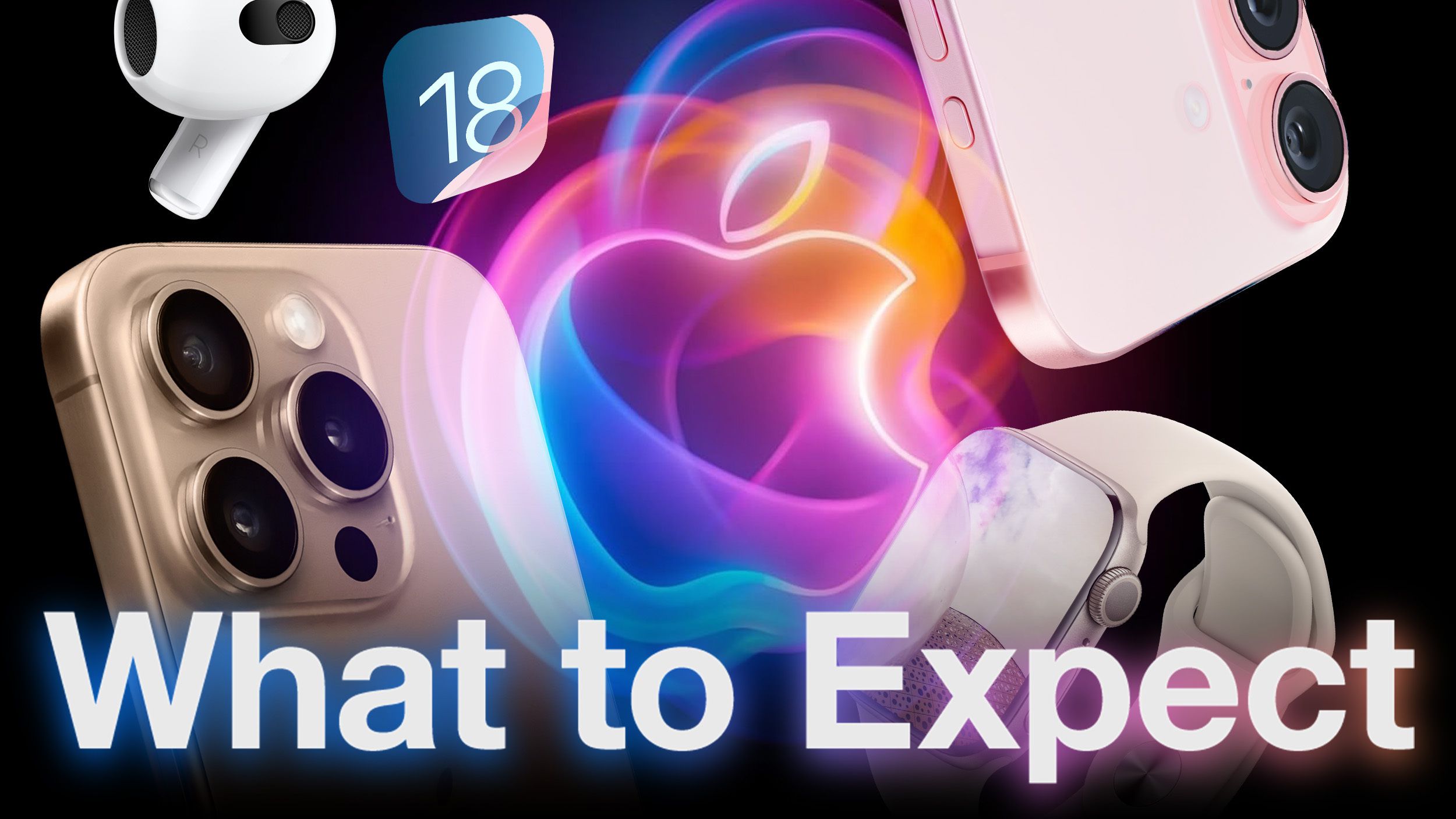Apple will hold its annual fall iPhone-centric event on Monday, September 9 at 10:00 a.m. Pacific Time. There are multiple new devices on the horizon, including new iPhone 16 models, refreshes for all of the Apple Watches, new AirPods 4, and perhaps some other surprises.
This guide highlights everything that we might see at Apple’s “It’s Glowtime” event based on current rumors.
iPhone 16 and iPhone 16 Plus
The iPhone 16 and 16 Plus will look almost identical to the iPhone 15 and iPhone 15 Plus, with few design changes planned, but there are new capabilities to look forward to.
Apple plans to bring the Action Button to the iPhone 16 and iPhone 16 Plus, so it won’t be a Pro-exclusive feature anymore and will be available on all iPhone 16 models. The Action Button can be set to turn on a Focus mode, activate a Shortcut, open the Camera, activate the Flashlight, and more. With iOS 18, it can do even more because you can also assign Control Center controls to the Action Button, and third-party developers can now make Control Center options.

 Dummy models featuring the rumored iPhone 16 colors
Dummy models featuring the rumored iPhone 16 colorsAlong with the Action Button, all iPhone 16 models could have a Capture Button, located on the right side of the iPhone below the Power Button. On U.S. iPhones, it will be located where the mmWave antenna is on the iPhone 15 models, with the antenna moving to the left with the iPhone 16 lineup. While most rumors have suggested it’s coming to all models, there is a chance that it could be limited to the Pro models.
The Capture Button will be used to take images and video, and it will respond to pressure and touch for extra gesture support. A light press will autofocus, while a harder press will take the shot. Swiping left and right will zoom in or out, and there may also be an option for swapping between photo and video modes.
Rather than the diagonal camera that Apple has used for the last several iPhone models, the iPhone 16 and 16 Plus will have a vertical camera arrangement for the dual-lens camera system. The vertical arrangement could allow for the iPhones to capture spatial video for the Vision Pro.
The Main camera isn’t expected to get an upgrade, but Apple might boost the aperture of the Ultra Wide camera to improve low-light performance and add support for macro mode for the first time.
There will be new colors for the iPhone 16 models, with some rumors suggesting we’ll see black, green, light pink, blue, and white for five total color options, and other rumors pointing toward green, white, pink, and blue. In both of these scenarios, the white replaces the yellow Apple used for the iPhone 15 models. Apple is rumored to be using the color-infused back glass that it used for the iPhone 15, but with a frosted effect for the glass that contrasts with the frame color.
Apple could opt for a more power efficient OLED display that might improve battery life while also increasing overall brightness.
A18 chips will be in all the iPhone 16 models, which means the standard iPhone 16 and iPhone 16 Plus will support the Apple Intelligence features that are coming in iOS 18. There could also be some iPhone-specific Apple Intelligence functionality that hasn’t yet been announced.
The A18 chips will be built on TSMC’s 3-nanometer process, with Apple expected to include Neural Engine improvements for Apple Intelligence. Both iPhone 16 models will get 8GB RAM, up from 6GB in the prior-generation models in order to support AI. Apple may also be planning for a new thermal design that will combat overheating and improve performance.
There could be some minor increases to battery life for the standard iPhone 16 model, as it is rumored to be getting a minor capacity boost. Depending on the chip efficiency, we could see some small improvements for both models, but that will depend on how much battery the new features eat up.
We have more on the features coming to the iPhone 16 in our roundup.
iPhone 16 Pro and iPhone 16 Pro Max
Like the iPhone 16 models, the iPhone 16 Pro and Pro Max will get the all-new Capture Button, and in these devices, it will be accompanied by some camera improvements.
Apple is planning for a 48-megapixel Ultra Wide lens that uses pixel binning down to 12-megapixels, and the end result is basically much better performance in low-light for your wide-angle shots and your macro photos. The 5x Telephoto lens that was limited to the 15 Pro Max will be coming to the 16 Pro, so both Pro models will have it this time around.


The iPhone 16 Pro models may be able to record 4K video at up to 120 frames per second, an increase over the current 60 frames per second limit when filming in 4K. Apple has also tested 8K recording, but it is not clear if that made it into the launch version of the device. Apple also plans to add a feature for pausing and resuming a video recording.
Display size is getting bigger, and it’s the first time we’ve seen an increase in display size since the iPhone 12. The iPhone 16 display will measure in at 6.3 inches, up from 6.1, while the iPhone 16 Pro Max will have a 6.9-inch display, up from 6.7 inches. The change is not drastic, but it will be noticeable if you have an iPhone 16 Pro next to an iPhone 15 Pro.
There could be some improvements to the Main camera, and there’s a chance the iPhone 16 Pro Max will have a new Sony sensor that offers higher-quality images with better dynamic range and noise control.
We’re also expecting the bezels around the edge of the display to be slimmed down, and Apple is rumored to be adopting more efficient OLED display technology, so we could see some improvements to brightness and contrast. According to Bloomberg‘s Mark Gurman, the bezels could be about a third smaller.
All of the iPhone 16 models will get an A18 chip, but there could be variants. Apple could use a higher-end A18 chip with an extra GPU core in the Pro models, which would let all iPhone 16 devices run Apple Intelligence, but would still provide for some differentiation between the Pro and non-Pro models. A new thermal architecture with a graphene heatsink and metal battery casing is expected, and while the heatsink is also coming to the iPhone 16, the other thermal changes could be Pro only.
Apple is expected to adopt Qualcomm’s X75 5G modem in the Pro models for faster 5G speeds through carrier aggregation. The X75 has a combined mmWave and sub-6GHz transceiver rather than using separate hardware, so it’s smaller and uses up less power.
We could see improvements in battery life with the X75 chip and the A18 processor, plus Apple is using slightly bigger batteries with a 5 to 9 percent jump in capacity. There have been rumors that the iPhone 16 Pro models will support Wi-Fi 7, but that’s also a feature Apple might hold until next year. As for storage, both Pro models could start with 256GB.
Early on, there were a few rumors about 20W MagSafe charging speeds and 40W wired charging speeds, but that’s sounding like a long shot now. The microphone will have better water resistance and better sound thanks to AI. There may also be some iPhone 16 Pro-specific Apple Intelligence features that we don’t know about yet.
As with every new iPhone launch, there are updated colors. We’re expecting the standard black, white, and natural titanium options, but this year’s special color is a shade of gold. Some rumors have described it as a bronze shade, and some dummy leaks have suggested that it’s a darker brown color than Apple’s prior gold selections, but color is so dependent on lighting that it’s hard to say for sure. Bloomberg‘s Mark Gurman says the shade “looks impressive and not terrible like the early renders.”
More detail on the iPhone 16 Pro’s expected features can be found in the iPhone 16 Pro roundup.
Apple Watch Series 10
Apple is refreshing the Apple Watch this year, but there are some ambiguities and questions about just what we’ll see. 2024 marks the 10th anniversary of when the Apple Watch was introduced in September 2014, and it will be the “Series 10,” but the Apple Watch launched in 2015. While there have been rumors of a major anniversary refresh, it’s been unclear if that will happen this year or next year.


The Apple Watch is expected to be slimmer than prior versions, and Apple is increasing the size. Rather than 41mm and 45mm models, it’s looking like we’ll get 45mm and 49mm options. Size could increase through a decrease in bezels and by making the casing itself larger. A 4mm jump will be a noticeable but not enormous size increase.
There were CAD renders of a next-generation Apple Watch with a 2-inch display, which is just slightly bigger than the 49mm Apple Watch Ultra display. That screen could be destined for the 49mm Series 10. Apple could boost water resistance with the design change, certifying the device for high-speed water sports up to 20 meters deep. The new Series 10 models may get the Depth app, which was first introduced for the Apple Watch Ultra.
Aside from the increase in size and the thinner design, the updated models are said to look like the current Apple Watch models with no radical changes. Early on, Bloomberg‘s Mark Gurman said that Apple was working on a new magnetic band attachment system, but it’s no longer sounding like that’s a feature we’re going to get this year.
Apple will update the OLED display to be more energy efficient, and with a bigger casing, battery size may increase too, leading to better battery life.
Apple is reportedly planning to include an updated heart rate and ECG sensor in the Apple Watch Series 10 that will enable new features like sleep apnea detection. Sleep apnea detection has been long rumored for the Series 10, but it was unclear if it would be implemented at launch because of an ongoing patent dispute that has seen Apple disable blood oxygen detection in the current-generation Apple watch models in the U.S.
Sleep apnea causes a person to stop breathing while asleep, which can lead to excessive tiredness. It is usually diagnosed through a sleep study, and fixing it requires a breathing apparatus like a CPAP machine. The Apple Watch Series 10 and Ultra 2 will reportedly be able to detect sleep apnea using Apple Watch sleep tracking, providing a reading after collecting sleep data for several days.
Apple also wanted to include blood pressure monitoring, but that feature was not ready for launch and will not be included in the Series 10.
For the last several years, the Apple Watch has used an S-series chip that’s changed little, but this year’s S10 is expected to bring a notable upgrade in performance. While the Apple Watch will not get “major” Apple Intelligence capabilities, there could perhaps be AI features tied to a future health coach service, according to Bloomberg‘s Mark Gurman.
We have additional details on what to expect for the Apple Watch in our roundup.
Apple Watch Ultra 3
If there are new health features in the Apple Watch Series 10, Apple will also add them to the next-generation Apple Watch Ultra that’s coming this fall. We aren’t expecting a new design or any other physical changes to the device, but it will get the same chip and health features that Apple plans to add to the Apple Watch Series 10.


Apple Watch SE 3
The Apple Watch SE 3 could get a refresh this fall, and there are rumors that Apple will use a plastic casing rather than an aluminum casing for the device.


A rigid plastic material would keep costs down, while also being more durable than aluminum in terms of scratches and drops. Such an Apple Watch could also be made in an array of bright colors, which would appeal to children.
Apple has been promoting the Apple Watch as an option for parents who want to give their kids a device for communication and safety, and a lower-cost Apple Watch SE could help and also differentiate the device from the aluminum Apple Watch models.
Apple has not used plastic for the casing of a device since the iPhone 5c, a phone that came in vibrant blue, yellow, pink, and green colors. Aside from a new material, the Apple Watch SE is expected to have the same general design with no updates and no other feature changes except for an improved chip.
AirPods 4
There are two versions of the AirPods 4 in the works, both of which feature a new design. The updated AirPods will look like a cross between the current AirPods and the AirPods Pro, with Apple adopting a shorter stem. Bloomberg‘s Mark Gurman says there will be an updated fit, but it’s not yet clear what that means.


The higher-priced AirPods 4 will have Active Noise Cancellation, a feature that has previously been limited to the AirPods Pro and the AirPods Max. The lower-end model will be a direct upgrade to the current AirPods 3.
Pricing on these new models isn’t known yet. The AirPods 3 cost $179 (with MagSafe case), the AirPods 2 are $129, and the AirPods Pro 2 are $249, so Apple needs to price the new model somewhere in the middle. The lower-cost AirPods 4 could get a price drop to put it closer in line with the AirPods 2, which will be discontinued, and the ANC model could be priced between $180 and $200, well below the AirPods Pro.
Apple is going to update the AirPods 4 case, and it could have a new look. It will get a speaker for Find My, allowing it to play a sound when lost, and it’ll have a USB-C port for charging instead of a Lightning port. MagSafe charging will also still be a feature.
Depending on design, the ANC probably won’t be on par with the ANC in the AirPods Pro as those have silicone ear tips, but there are rumors of improvements to sound quality.
Eventually, Apple plans to announce hearing aid replacement functionality for the AirPods, plus it will add an option for conducting hearing tests with the earbuds. These features may not be available when the AirPods launch, instead coming at a later date.
Other Unlikely Possibilities
AirPods Max
Apple plans to refresh the AirPods Max in 2024, but don’t get excited. We aren’t expecting any new features except for a USB-C port instead of a Lightning port, and possibly new color options. It’s more likely that the AirPods Max refresh will come later in the year than at the September event.


iPad mini 7
The iPad mini 7 could see an update in 2024, but it likely won’t be coming at Apple’s September event. Apple is said to be planning to hold a second event in October 2024, and it would make more sense for the new iPad mini to come out then alongside new M4 Macs.


Few changes are expected for the next-generation iPad mini, and it will continue to have an 8.3-inch display size with Touch ID power button. There could be a small change to the display to cut down on the “jelly scrolling” effect that some people complained about with the iPad mini 6. Jelly scrolling refers to the sometimes noticeable lag when scrolling vertically through text-based content like a webpage.
We are expecting the iPad mini to have a variant of the A17 or A18 chip that is compatible with Apple Intelligence, and we could get new colors, an upgraded front-facing camera, and support for Wi-Fi 6E.
iPad 11
The iPad hasn’t been refreshed since 2022, and it is overdue for an update. There are rumors suggesting we could get a new model in 2024, but it too will likely come out later in the year.


There are no rumors about new features for the next-generation iPad, but it is expected to get a better A-series chip.
Software Updates
iOS 18, iPadOS 18, macOS Sequoia, tvOS 18, watchOS 11, and visionOS 2 are in beta testing, and at the fall event, Apple will give us a heads up on when the new operating system updates will be released.


Typically iOS 18 and its sister updates come out just a few days ahead of when new iPhones launch, so if the iPhone 16 models launch on Friday, September 20 after their September 9 debut date, we could see the software come out earlier in the week of September 20.
There may also be Apple Intelligence features that are exclusive to the iPhone 16 models that Apple has been keeping under wraps, so there may be some software-based surprises coming.
How to Watch
Apple’s “It’s Glowtime” event will start at 10:00 a.m. Pacific Time on Monday, September 9. Apple will livestream the event on its website and on YouTube, plus the livestream will be available through the Apple TV app on supported devices.
For those unable to watch the livestream, MacRumors will be providing full event coverage on MacRumors.com and the MacRumorsLive Twitter account, plus we’ll do a much deeper dive into all the announcements over the course of the next week.

